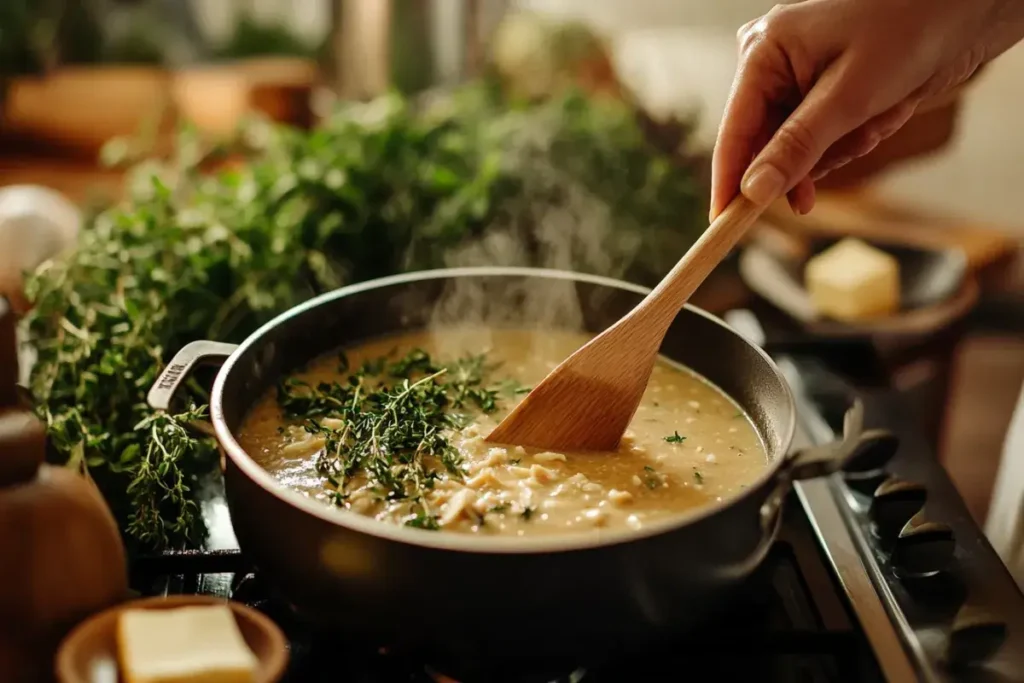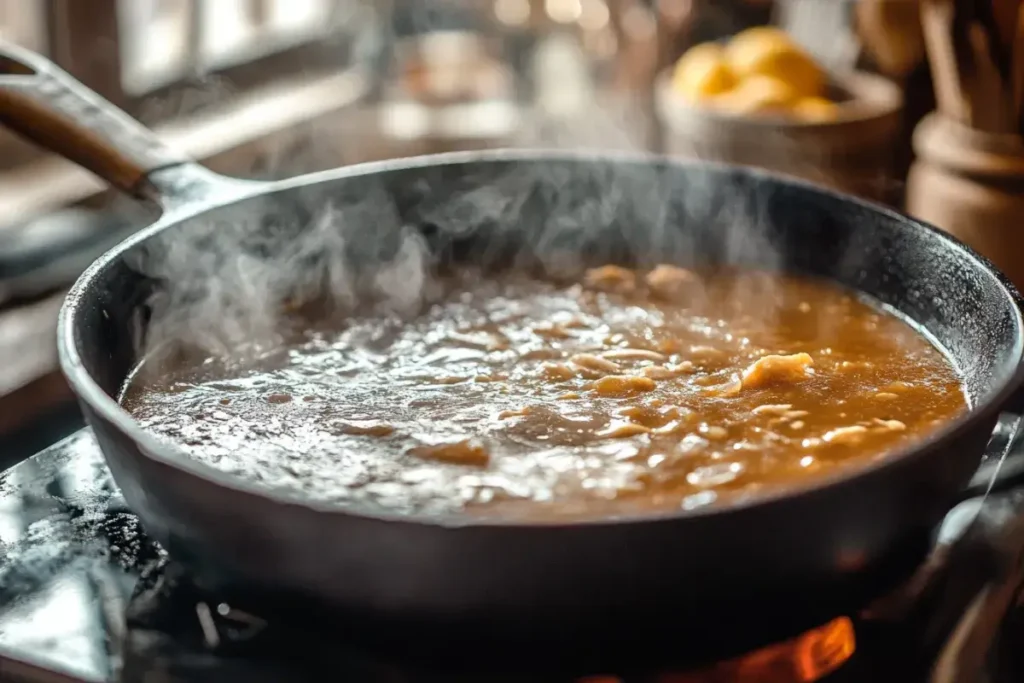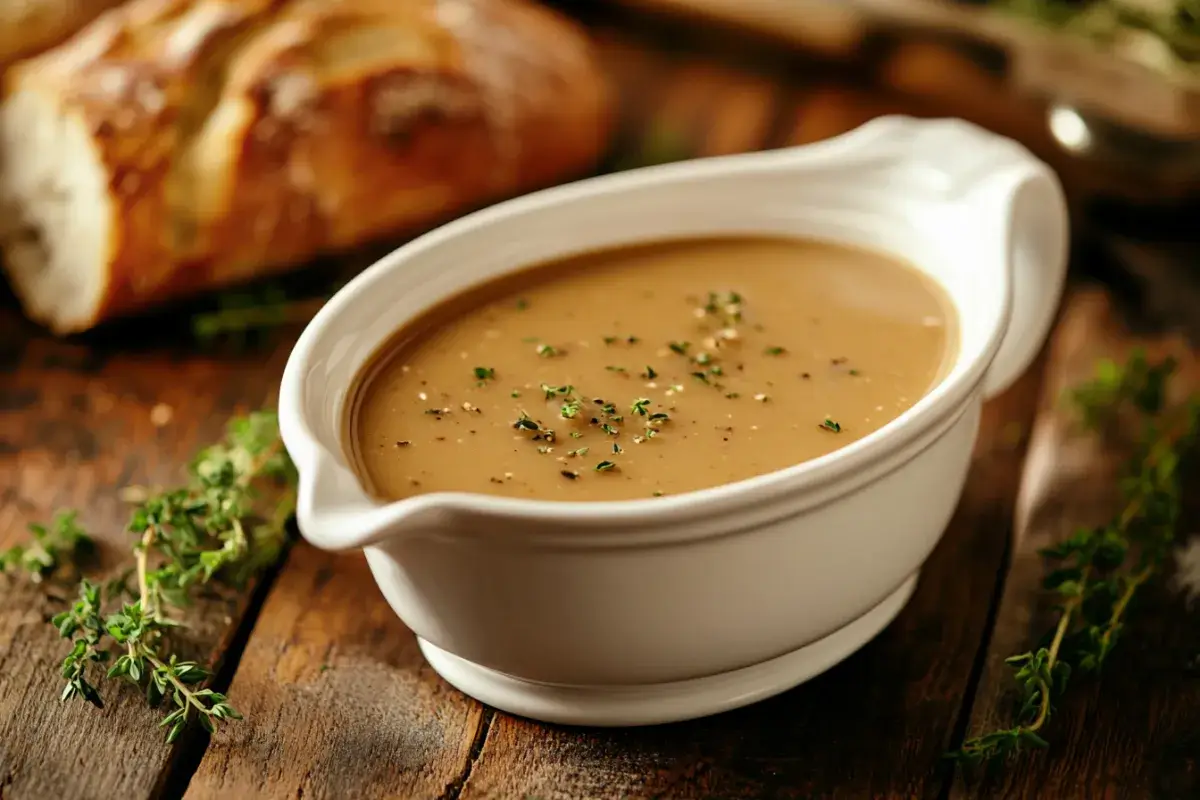Chicken gravy can be the perfect finishing touch to a meal, but often it doesn’t hit the mark when it comes to flavor. If you’re wondering, “How can I make chicken gravy taste better?”, you’re in the right place. Elevating your gravy doesn’t take much; with just a few tweaks, you can create a sauce that’s rich, flavorful, and perfectly balanced. In this article, we’ll explore some easy ways to transform your chicken gravy from bland to delicious.
The Basics of a Great Chicken Gravy
Before diving into tips for improvement, it’s essential to get the basics right. A good way to make chicken gravy taste better starts with a simple but well-executed recipe. Here’s a quick guide to the essentials:
- Stock or broth: Using high-quality chicken stock or broth is key. If possible, use homemade broth or stock for the richest flavor. However, if you’re in a pinch, opt for a low-sodium store-bought option.
- Roux: A combination of butter and flour forms the base for thickening the gravy. Cooking the roux until it’s golden brown gives the gravy a deeper, richer flavor.
- Seasoning: Don’t underestimate the importance of seasoning. A pinch of salt and pepper is a good start, but you’ll want to experiment with other spices and herbs to take it up a notch.
To avoid common mistakes, always taste as you go. Gravy often lacks flavor because people fail to adjust seasoning during the cooking process. Thus, tasting throughout ensures a better final product.
How to Add Depth to Chicken Gravy
Adding depth to your chicken gravy can take it from ordinary to extraordinary. One of the best ways to do this is by improving the quality of your stock or broth.
- Slow simmering: Allowing the gravy to simmer slowly helps meld flavors together, giving it a more intense taste. Don’t rush this step! Give the gravy time to reduce, which naturally enhances its depth.
- Use chicken drippings: If you’ve roasted a chicken, don’t throw away the drippings. Drippings are packed with flavor and fat, which can significantly improve your gravy. Use a fat separator to remove excess fat, keeping just the flavorful juices.
Incorporating homemade chicken drippings not only adds richness but also a touch of authenticity to your dish.
Moreover, reducing the gravy slightly while simmering helps intensify the flavor. As it reduces, the taste of the chicken and seasonings become more pronounced, giving you a gravy that’s far more flavorful.
Boosting Flavor with Herbs and Spices
One of the easiest ways to improve the flavor of your gravy is by adding herbs and spices. The right combination can bring out subtle notes that transform your gravy from dull to dynamic.

- Herbs: Fresh herbs like thyme, rosemary, and sage work beautifully with chicken gravy. If you don’t have fresh herbs on hand, dried herbs can be used, but keep in mind that dried herbs have a more concentrated flavor.
- Spices: Common spices like black pepper, garlic powder, and onion powder can boost flavor without overwhelming the natural taste of the chicken. A dash of smoked paprika adds a slight smokiness and depth to the gravy.
The key here is balance. You want to elevate the gravy’s flavor without overpowering it. Therefore, start with small amounts and taste as you go. If you’re unsure which herbs and spices work best, check out This guide on pairing herbs with chicken.
Herbs like thyme, rosemary, and sage are perfect for bringing out subtle flavors in chicken gravy. You can find a great example of this in our Chicken and Gravy Recipe, which uses these herbs to enhance the dish
Additionally, you can experiment by creating your own custom herb blend. Using a combination of fresh and dried herbs can provide a more layered and complex flavor profile, making your chicken gravy taste even better.
Infusing Umami into Chicken Gravy
Umami, often referred to as the “fifth taste,” can be the secret to making your gravy more savory and mouthwatering. It’s the rich, savory taste that makes a dish feel complete and satisfying.
Here’s how you can add umami to your chicken gravy:
- Soy sauce: A small splash of soy sauce can enhance the umami in your gravy without making it taste like soy sauce. It’s especially helpful if your gravy tastes flat or lacks depth.
- Worcestershire sauce: Another umami booster, Worcestershire sauce adds a subtle tanginess and savory complexity to chicken gravy.
When using these umami-rich ingredients, remember that a little goes a long way. Add them slowly and adjust to taste. The goal is to create a richer, more savory gravy without overpowering the other flavors. Ultimately, umami is what makes your gravy more memorable and crave-worthy.
Creamy Chicken Gravy: How to Perfect the Texture
Sometimes, you want your gravy to be a little creamier. A silky, smooth texture not only tastes good but also gives the gravy a luxurious mouthfeel. Achieving this requires a delicate balance, as it’s easy to create lumps or make the gravy too thick.
To perfect the texture of your creamy chicken gravy:
- Add cream or milk: A splash of cream, milk, or half-and-half can take your gravy to the next level. Cream not only enhances the flavor but also provides a smooth consistency.
- Use cornstarch as a thickener: If you want to thicken your gravy without flour, cornstarch is a great alternative. Just mix cornstarch with a bit of water to create a slurry and slowly add it to your simmering gravy. This helps avoid lumps and ensures a silky, smooth finish.
When adding cream or thickening agents, always whisk continuously to avoid clumps. Take your time to ensure everything blends well together, resulting in a velvety gravy that tastes as good as it looks. By perfecting this step, you can make your gravy the highlight of the meal rather than just an afterthought.
The Role of Acidity in Chicken Gravy
If your gravy is tasting a little one-dimensional, it might need a touch of acidity. Acids help brighten the flavors and make everything more vibrant, but you have to be careful not to overdo it.
- Lemon juice: Just a small squeeze of fresh lemon juice can balance the richness of the gravy, making it taste lighter and more refreshing.
- Vinegar: If you don’t have lemon juice, a splash of vinegar (like apple cider or white wine vinegar) can achieve the same effect.
The key here is moderation. Start with a tiny amount of acid and taste frequently to ensure you’re not overpowering the other flavors. You want the acidity to complement the richness of the gravy, not dominate it. Thus, adjusting the balance carefully will result in a better-tasting and more complex gravy.
Mastering chicken gravy isn’t just about following a recipe. It’s about understanding how to elevate the basic elements — from the quality of your stock to the balance of herbs and spices — and making adjustments along the way. By incorporating deeper flavors through slow simmering, using the right aromatics, and experimenting with ingredients like soy sauce for umami, your chicken gravy will no longer be just an afterthought on the dinner table but a star component of the meal.
Enhancing Chicken Gravy with Vegetables
A simple but highly effective way to enhance the flavor of your chicken gravy is by incorporating vegetables. This approach not only adds depth to the gravy but also introduces new layers of taste that pair well with roasted or grilled chicken.
- Sautéing vegetables: Start by sautéing vegetables like onions, garlic, celery, and carrots. These ingredients create a flavorful base that adds complexity to your gravy. Cook them until they’re soft and golden brown, as this releases their natural sweetness.
- Roasting for depth: Roasting the vegetables beforehand can introduce a smoky, caramelized flavor to your gravy. The longer you roast the vegetables, the richer the flavors will be.
- Straining or blending: After the vegetables have simmered in the gravy, you have two options. You can strain them out for a smooth, velvety texture, or blend them into the gravy for a thicker, heartier consistency.
By incorporating these vegetables, you’re not only adding more flavor but also creating a more robust gravy that complements the savory taste of chicken. This simple addition will bring your gravy to the next level.
How to Save Salty or Bland Gravy
It happens to the best of us — sometimes gravy ends up too salty or bland. Luckily, there are ways to fix these common problems without having to start over.
Saving Salty Gravy
When your gravy is too salty, there are several ways to tone it down:
- Add more liquid: Diluting the gravy with additional chicken stock or water can help reduce the saltiness. Be careful not to dilute it too much, though, or you’ll lose flavor.
- Incorporate a starch: Adding ingredients like mashed potatoes or cooked rice can help absorb excess salt. Stir them in gradually and taste after each addition.
- Balance with cream or milk: Sometimes, a splash of cream or milk can balance out overly salty gravy by adding richness that mellows the saltiness.
Fixing Bland Gravy
If your gravy tastes bland, it’s usually a sign that it needs more seasoning or depth. Here are a few quick fixes:
- Add salt in stages: It’s always best to add salt incrementally, tasting as you go. If you’ve under-seasoned your gravy, try adding small amounts of salt and tasting after each addition.
- Boost flavors with herbs and spices: Adding a touch of thyme, sage, or even smoked paprika can bring a bland gravy to life. Don’t forget to add freshly cracked black pepper as well.
- Use a flavor enhancer: A small splash of soy sauce can work wonders for a flat gravy, introducing savory notes and depth.
By carefully adjusting the flavors, you can save your gravy from disaster and ensure it complements your meal perfectly.
Creative Add-Ins for Unique Flavors
If you’re looking to make your chicken gravy truly stand out, try experimenting with creative add-ins that introduce unexpected but complementary flavors. These additions will help your gravy taste richer, more complex, and distinctly your own.
- Mushroom powder: For a subtle earthy flavor, add a small amount of mushroom powder to your gravy. Mushrooms are naturally rich in umami, which enhances the savory profile of the dish.
- Mustard: A teaspoon of mustard can add a tangy depth that works surprisingly well in chicken gravy. Dijon mustard or grainy mustard adds just enough sharpness without overpowering the gravy.
- Horseradish: If you want a little heat, try stirring in a tiny amount of horseradish. It provides a zesty kick while keeping the flavors balanced.
These ingredients will make your gravy more memorable, offering new layers of flavor that can surprise and delight your guests.
Making Chicken Gravy Gluten-Free
If you or your guests are following a gluten-free diet, you don’t have to sacrifice the flavor or texture of your gravy. By using alternative thickening agents, you can still create a rich, satisfying gravy without flour.
- Cornstarch slurry: The easiest way to make gluten-free gravy is to replace the flour with cornstarch. Simply mix cornstarch with water to form a slurry, and then stir it into your simmering gravy. Keep whisking as it thickens to avoid clumps.
- Arrowroot powder: For a more subtle thickener, try arrowroot powder, which behaves similarly to cornstarch. It’s perfect for those who prefer a lighter texture in their gravy.
- Potato starch: Another great gluten-free thickener is potato starch. It’s a versatile option that doesn’t alter the flavor of your gravy while providing a smooth, consistent texture.
By using these gluten-free alternatives, you can ensure everyone at the table can enjoy your delicious gravy without any dietary concerns.
Incorporating Aromatics into Chicken Gravy
Aromatics are essential for building flavor in any dish, and chicken gravy is no exception. The right aromatics can transform a simple gravy into a rich, flavorful sauce that complements the natural taste of the chicken.

- Garlic and shallots: Adding minced garlic or finely chopped shallots to your gravy base can bring a subtle, savory sweetness that enhances the overall flavor.
- Leeks and onions: For a slightly milder flavor, consider using leeks or yellow onions. Sautéing these aromatics before adding the stock will deepen the flavor of your gravy.
- Herb-infused oils: You can also use herb-infused oils like rosemary or thyme oil to drizzle into the gravy. This creates a rich aromatic profile without the need for whole herbs.
Aromatics not only boost flavor but also create a well-rounded gravy that pairs beautifully with a variety of chicken dishes. By incorporating these, you ensure that every bite is flavorful from start to finish.
Enhancing Gravy with Fat and Butter
Adding fat to your gravy gives it a smooth, luxurious texture while enriching the flavor. The right balance of fat can make the difference between a gravy that’s thin and watery and one that’s thick, rich, and indulgent.
- Use butter or chicken fat: Start by using butter or chicken fat (also known as schmaltz) in your gravy base. These fats not only thicken the gravy but also contribute to its flavor. Just be careful not to add too much, as this can make the gravy greasy.
- Balance fat with stock: While fat adds richness, it’s important to balance it with enough chicken stock or broth to keep the gravy from becoming too heavy. Use a fat separator to remove excess fat if necessary.
By finding the right ratio of fat to stock, you’ll create a perfectly textured gravy that complements your dish without overwhelming it.
Final Adjustments: Taste and Presentation
Once you’ve perfected your gravy, it’s time for the final adjustments. This step ensures your gravy not only tastes amazing but also looks appetizing when served.
- Taste for seasoning: Before serving, always taste your gravy one last time to ensure that the salt and seasoning are balanced. If needed, adjust with a bit more salt, pepper, or herbs.
- Garnish with fresh herbs: For an elegant touch, garnish the gravy with freshly chopped parsley or thyme right before serving. Not only does this add a pop of color, but it also enhances the aroma.
- Serve immediately: Gravy is best served hot, so ensure you serve it immediately or keep it warm on the stove until the rest of your meal is ready.
By making these small adjustments before serving, you can ensure that your gravy is flavorful and visually appealing, enhancing the overall dining experience.
Conclusion
Perfecting chicken gravy takes time, practice, and a bit of creativity. By experimenting with vegetables, herbs, spices, and alternative thickening agents, you can take your gravy to new heights. Whether you’re fixing bland or salty gravy, making it gluten-free, or simply adding rich aromatics, the key is to keep tasting and adjusting until you achieve a balance of flavors that complements your meal.
Once you’ve mastered these techniques, your chicken gravy will no longer be just an afterthought. Instead, it will be a rich, flavorful sauce that enhances every meal, making it the star of the dinner table.
FAQs
1. Why does my chicken gravy taste bland?
- Gravy often tastes bland because it lacks seasoning or depth. You can enhance the flavor by adding more salt, herbs, and umami-rich ingredients like soy sauce.
2. How can I thicken my chicken gravy without using flour?
- You can thicken your gravy with cornstarch, arrowroot powder, or potato starch. These gluten-free alternatives work just as well as flour.
3. Can I make chicken gravy without drippings?
- Yes, you can make flavorful chicken gravy without drippings by using chicken broth or stock as the base. Adding herbs, spices, and umami boosters will help intensify the flavor.
4. How do I make my chicken gravy less salty?
- To fix salty gravy, add more liquid such as low-sodium broth or water. You can also incorporate a starch, like mashed potatoes, to absorb the excess salt.
5. How can I store and reheat chicken gravy?
- Place any leftover gravy in a sealed container and refrigerate for up to 3 days. When reheating, warm it slowly over low heat and whisk to restore its smooth texture.

